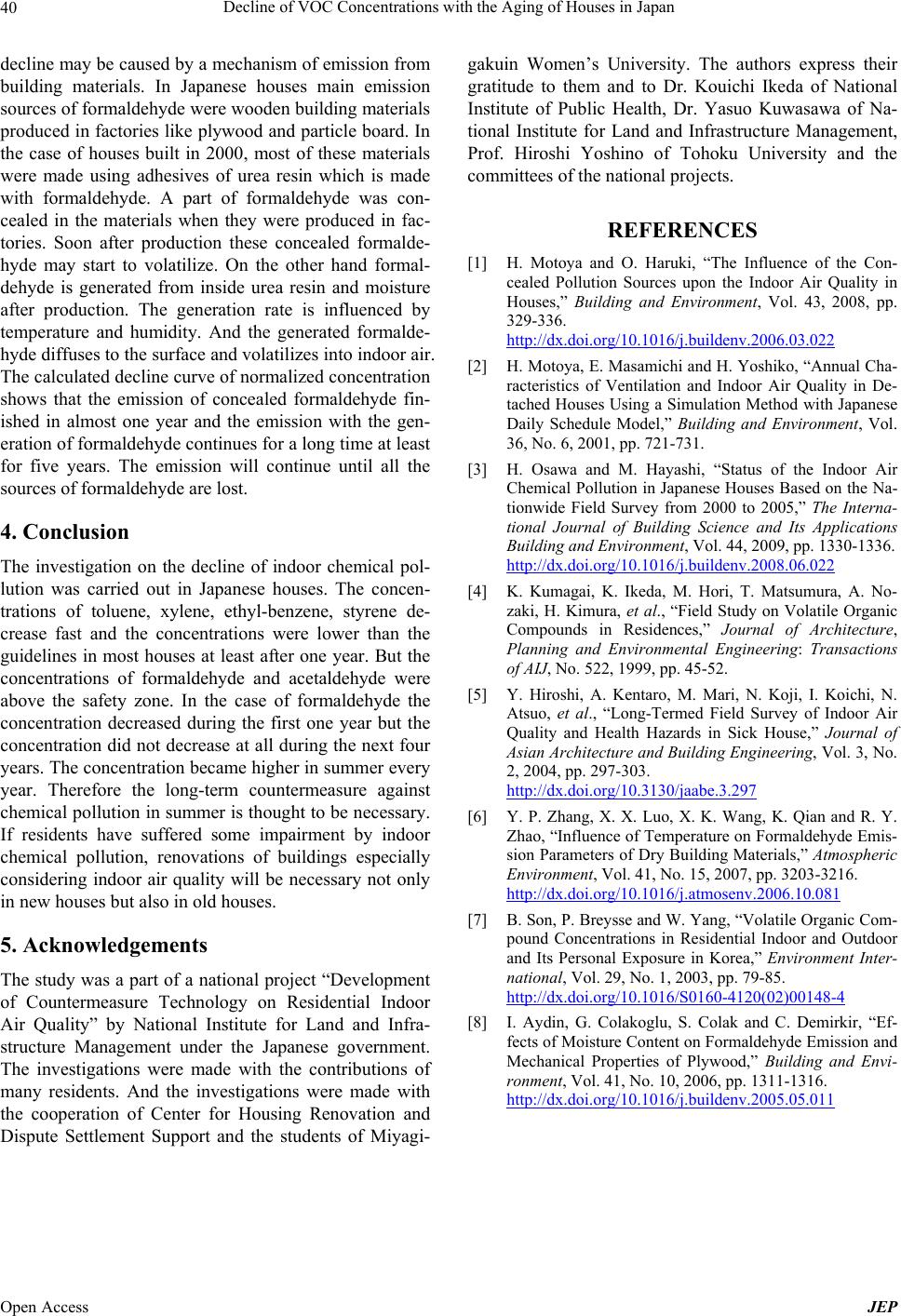
Decline of VOC Concentrations with the Aging of Houses in Japan
Open Access JEP
40
decline may be caused by a mechanism of emission from
building materials. In Japanese houses main emission
sources of formaldehyde were wooden building materials
produced in factories like plywood and particle board. In
the case of houses built in 2000, most of these materials
were made using adhesives of urea resin which is made
with formaldehyde. A part of formaldehyde was con-
cealed in the materials when they were produced in fac-
tories. Soon after production these concealed formalde-
hyde may start to volatilize. On the other hand formal-
dehyde is generated from inside urea resin and moisture
after production. The generation rate is influenced by
temperature and humidity. And the generated formalde-
hyde diffuses to the surface and volatilizes into indoor air.
The calculated decline curve of normalized concentration
shows that the emission of concealed formaldehyde fin-
ished in almost one year and the emission with the gen-
eration of formaldeh yde contin ues for a long ti me at least
for five years. The emission will continue until all the
sources of formaldehyde are lost.
4. Conclusion
The investigation on the decline of indoor chemical pol-
lution was carried out in Japanese houses. The concen-
trations of toluene, xylene, ethyl-benzene, styrene de-
crease fast and the concentrations were lower than the
guidelines in most houses at least after one year. But the
concentrations of formaldehyde and acetaldehyde were
above the safety zone. In the case of formaldehyde the
concentration decreased during the first one year but the
concentration did not decrease at all during the next four
years. The concentration became higher in summer every
year. Therefore the long-term countermeasure against
chemical pollution in su mmer is thought to be necessary.
If residents have suffered some impairment by indoor
chemical pollution, renovations of buildings especially
considering indoor air quality will be necessary not only
in new houses but als o in ol d ho uses.
5. Acknowledgements
The study was a part of a national project “Development
of Countermeasure Technology on Residential Indoor
Air Quality” by National Institute for Land and Infra-
structure Management under the Japanese government.
The investigations were made with the contributions of
many residents. And the investigations were made with
the cooperation of Center for Housing Renovation and
Dispute Settlement Support and the students of Miyagi-
gakuin Women’s University. The authors express their
gratitude to them and to Dr. Kouichi Ikeda of National
Institute of Public Health, Dr. Yasuo Kuwasawa of Na-
tional Institute for Land and Infrastructure Management,
Prof. Hiroshi Yoshino of Tohoku University and the
committees of the nationa l pro jects.
REFERENCES
[1] H. Motoya and O. Haruki, “The Influence of the Con-
cealed Pollution Sources upon the Indoor Air Quality in
Houses,” Building and Environment, Vol. 43, 2008, pp.
329-336.
http://dx.doi.org/10.1016/j.buildenv.2006.03.022
[2] H. Motoya, E. Masamichi and H. Yoshiko, “Annual Cha-
racteristics of Ventilation and Indoor Air Quality in De-
tached Houses Using a Simulation Method with Japanese
Daily Schedule Model,” Building and Environment, Vol.
36, No. 6, 2001, pp. 721-731.
[3] H. Osawa and M. Hayashi, “Status of the Indoor Air
Chemical Pollution in Japanese Houses Based on the Na-
tionwide Field Survey from 2000 to 2005,” The Interna-
tional Journal of Building Science and Its Applications
Building and Environment, Vol. 44, 2009, pp. 1330-1336.
http://dx.doi.org/10.1016/j.buildenv.2008.06.022
[4] K. Kumagai, K. Ikeda, M. Hori, T. Matsumura, A. No-
zaki, H. Kimura, et al., “Field Study on Volatile Organic
Compounds in Residences,” Journal of Architecture,
Planning and Environmental Engineering: Transactions
of AIJ, No. 522, 1999, pp. 45-52.
[5] Y. Hiroshi, A. Kentaro, M. Mari, N. Koji, I. Koichi, N.
Atsuo, et al., “Long-Termed Field Survey of Indoor Air
Quality and Health Hazards in Sick House,” Journal of
Asian Architecture and Building Engineering, Vol. 3, No.
2, 2004, pp. 297-303.
http://dx.doi.org/10.3130/jaabe.3.297
[6] Y. P. Zhang, X. X. Luo, X. K. Wang, K. Qian and R. Y.
Zhao, “Influence of Temperature on Formaldehyde Emis-
sion Parameters of Dry Building Materials,” Atmospheric
Environment, Vol. 41, No. 15, 2007, pp. 3203-3216.
http://dx.doi.org/10.1016/j.atmosenv.2006.10.081
[7] B. Son, P. Breysse and W. Yang, “Volatile Organic Com-
pound Concentrations in Residential Indoor and Outdoor
and Its Personal Exposure in Korea,” Environment Inter-
national, Vol. 29, No. 1, 2003, pp. 79-85.
http://dx.doi.org/10.1016/S0160-4120(02)00148-4
[8] I. Aydin, G. Colakoglu, S. Colak and C. Demirkir, “Ef-
fects of Moisture Content on Formaldehyde Emission and
Mechanical Properties of Plywood,” Building and Envi-
ronment, Vol. 41, No. 10, 2006, pp. 1311-1316.
http://dx.doi.org/10.1016/j.buildenv.2005.05.011